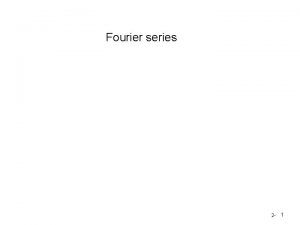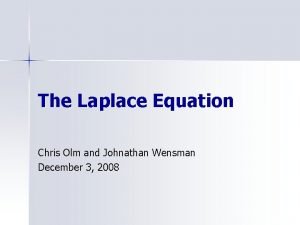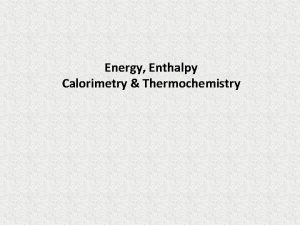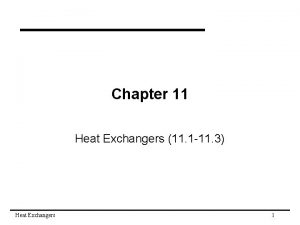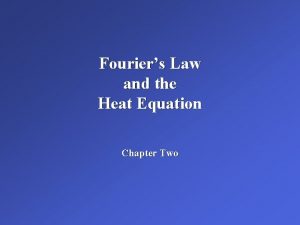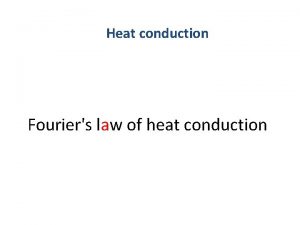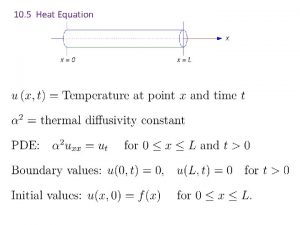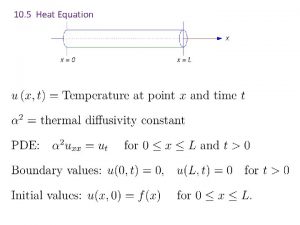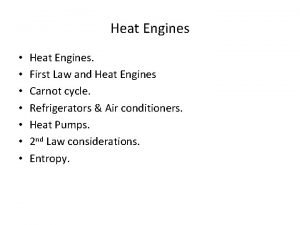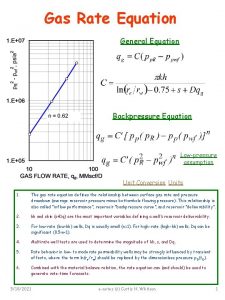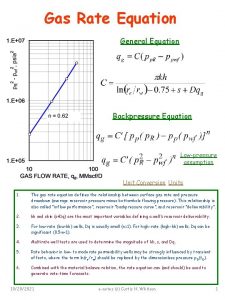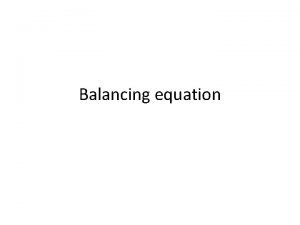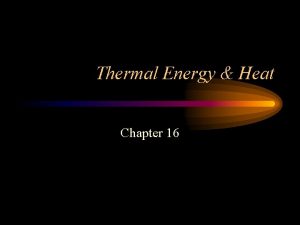Fouriers Law and the Heat Equation Chapter Two


















- Slides: 18

Fourier’s Law and the Heat Equation Chapter Two

Fourier’s Law • A rate equation that allows determination of the conduction heat flux from knowledge of the temperature distribution in a medium • Its most general (vector) form for multidimensional conduction is: Implications: – Heat transfer is in the direction of decreasing temperature (basis for minus sign). – Fourier’s Law serves to define thermal conductivity of the medium – Direction of heat transfer is perpendicular to lines of constant temperature (isotherms). – Heat flux vector may be resolved into orthogonal components.

Heat Flux Components • Cartesian Coordinates: (2. 3) • Cylindrical Coordinates: (2. 24) • Spherical Coordinates: (2. 27)

Heat Flux Components (cont. ) • In angular coordinates , the temperature gradient is still based on temperature change over a length scale and hence has units of C/m and not C/deg. • Heat rate for one-dimensional, radial conduction in a cylinder or sphere: – Cylinder or, – Sphere

Heat Equation The Heat Equation • A differential equation whose solution provides the temperature distribution in a stationary medium. • Based on applying conservation of energy to a differential control volume through which energy transfer is exclusively by conduction. • Cartesian Coordinates: (2. 19) Net transfer of thermal energy into the control volume (inflow-outflow) Thermal energy generation Change in thermal energy storage

Heat Equation (Radial Systems) • Cylindrical Coordinates: (2. 26) • Spherical Coordinates: (2. 29)

Heat Equation (Special Case) • One-Dimensional Conduction in a Planar Medium with Constant Properties and No Generation becomes

Boundary Conditions Boundary and Initial Conditions • For transient conduction, heat equation is first order in time, requiring specification of an initial temperature distribution: • Since heat equation is second order in space, two boundary conditions must be specified. Some common cases: Constant Surface Temperature: Constant Heat Flux: Applied Flux Convection: Insulated Surface

Properties Thermophysical Properties Thermal Conductivity: A measure of a material’s ability to transfer thermal energy by conduction. Thermal Diffusivity: A measure of a material’s ability to respond to changes in its thermal environment. Property Tables: Solids: Tables A. 1 – A. 3 Gases: Table A. 4 Liquids: Tables A. 5 – A. 7

Properties (Micro- and Nanoscale Effects) Micro- and Nanoscale Effects • Conduction may be viewed as a consequence of energy carrier (electron or phonon) motion. • For the solid state: (2. 7) energy carrier specific heat per unit volume. mean free path → average distance traveled by an energy carrier before a collision. average energy carrier velocity, • Energy carriers also collide with physical boundaries, affecting their propagation. Ø External boundaries of a film of material. thick film (left) and thin film (right).

Properties (Micro- and Nanoscale Effects) (2. 9 a) (2. 9 b) Ø Grain boundaries within a solid Measured thermal conductivity of a ceramic material vs. grain size, L. • Fourier’s law does not accurately describe the finite energy carrier propagation velocity. This limitation is not important except in problems involving extremely small time scales.

Conduction Analysis Typical Methodology of a Conduction Analysis • Consider possible microscale or nanoscale effects in problems involving very small physical dimensions or very rapid changes in heat or cooling rates. • Solve appropriate form of heat equation to obtain the temperature distribution. • Knowing the temperature distribution, apply Fourier’s Law to obtain the heat flux at any time, location and direction of interest. • Applications: Chapter 3: Chapter 4: Chapter 5: One-Dimensional, Steady-State Conduction Two-Dimensional, Steady-State Conduction Transient Conduction

Problem: Thermal Response of Plane Wall Problem 2. 57 Thermal response of a plane wall to convection heat transfer.

Problem: Thermal Response (cont). < <

Problem: Thermal Response (Cont). < d) The total energy transferred to the wall may be expressed as Dividing both sides by As. L, the energy transferred per unit volume is <

Problem: Non-uniform Generation due to Radiation Absorption Problem 2. 37 Surface heat fluxes, heat generation and total rate of radiation absorption in an irradiated semi-transparent material with a prescribed temperature distribution.

Problem : Non-uniform Generation (cont. )

Problem : Non-uniform Generation (cont. )
 Fouriers law
Fouriers law Fourier's trick
Fourier's trick Laplace equation
Laplace equation Newton's first law and second law and third law
Newton's first law and second law and third law Newton's first law
Newton's first law V=k/p
V=k/p Boyle's law charles law avogadro's law
Boyle's law charles law avogadro's law Latent heat problems
Latent heat problems Enthalpy of solution formula
Enthalpy of solution formula Specific heat capacity table pdf
Specific heat capacity table pdf Moist cooking methods
Moist cooking methods Hess law constant heat summation
Hess law constant heat summation Single pass cross flow heat exchanger
Single pass cross flow heat exchanger In shell and tube surface condenser
In shell and tube surface condenser Hát kết hợp bộ gõ cơ thể
Hát kết hợp bộ gõ cơ thể Frameset trong html5
Frameset trong html5 Bổ thể
Bổ thể Tỉ lệ cơ thể trẻ em
Tỉ lệ cơ thể trẻ em Voi kéo gỗ như thế nào
Voi kéo gỗ như thế nào

